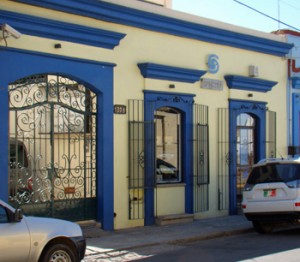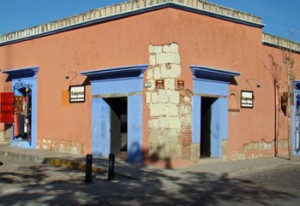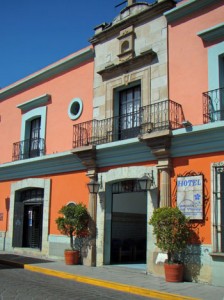Stone, brick and concrete: In southern Mexico, where wood and steel are costly, homes and offices are built with materials from the earth. The oldest buildings are constructed of quarried stone, traditionally a green-tinted limestone, or sun-baked coffee-colored adobe bricks. These were used to construct massive walls, often a meter thick, which not only supported the addition of upper stories, but kept the interior living spaces cool during the heat of the day.
Now, with greater awareness of how earthquakes work in this volcanic region, more modern buildings are constructed with a reinforced concrete framework that is filled in with kiln-fired brick or concrete block. But whatever the techniques used, these materials are cold and heavy and might have created an urban landscape that looks dreary and industrial.
Mexicans love beauty, music, art and celebration, and these values are reflected in a hundred creative ways in their homes and offices. They have discovered ways to make these cold materials express joy.
I took a walk through the Oaxaca Zocalo and surrounding streets, paying special attention to the buildings. You won’t find a single structure in Oaxaca that looks like another; whereas Americans seem to prefer living in cookie-cutter communities ruled by iron-fisted boards who live to enforce blandness and conformity, Mexicans let their creativity run free.
 Here is a simple home that has been converted into a business office for a company called Spectra. The windows and doors protrude slightly from the surface of the exterior wall to give 3-dimensional interest to what might otherwise have been a flat, unbroken surface. Cornices have been constructed over the arched wall openings, with a duplicate coping detail running the length of the parapet wall at the roof line. Contrasting colors are used like this in many Oaxaca buildings to draw the eye to these decorative elements. Even the wrought iron grill work, so commonly used for security, is full of curves and arcs meant to distract your attention from its primary quality — strength.
Here is a simple home that has been converted into a business office for a company called Spectra. The windows and doors protrude slightly from the surface of the exterior wall to give 3-dimensional interest to what might otherwise have been a flat, unbroken surface. Cornices have been constructed over the arched wall openings, with a duplicate coping detail running the length of the parapet wall at the roof line. Contrasting colors are used like this in many Oaxaca buildings to draw the eye to these decorative elements. Even the wrought iron grill work, so commonly used for security, is full of curves and arcs meant to distract your attention from its primary quality — strength.
The materials beneath the surface are probably ordinary brick and stone, but with the use of decorative concrete castings and an appealing paint scheme, these cold construction materials have been given warmth and beauty. Mexicans are masters at transforming their cities into places that are appealing to the eyes.
 The Guapinol store (guapinol is a very tall and massive evergreen tree) is a squat but massive building constructed of huge limestone blocks, requiring very deep door and window penetrations, as well as heavy lintels over the doors. The stone has been plastered over and the windows and roof line have been enhanced by some modest cast cornices and copings. Here, however, the owners have added interest by stripping away portions of the exterior plaster to show off the original stone and brick underneath. The stone work along the entire parapet is also exposed, which ties it to the exposed stone at the building’s corner and along the base of the walls. Pleasing colors brighten the building and frame the doorways, but what really sets this building apart are the contrasts in texture between the smooth, unbroken surface of the plastered wall and the irregular joints of the exposed stonework.
The Guapinol store (guapinol is a very tall and massive evergreen tree) is a squat but massive building constructed of huge limestone blocks, requiring very deep door and window penetrations, as well as heavy lintels over the doors. The stone has been plastered over and the windows and roof line have been enhanced by some modest cast cornices and copings. Here, however, the owners have added interest by stripping away portions of the exterior plaster to show off the original stone and brick underneath. The stone work along the entire parapet is also exposed, which ties it to the exposed stone at the building’s corner and along the base of the walls. Pleasing colors brighten the building and frame the doorways, but what really sets this building apart are the contrasts in texture between the smooth, unbroken surface of the plastered wall and the irregular joints of the exposed stonework.
Many of the buildings in Oaxaca date back to the time of the Spanish colonial expansion of the 16th century. Though they have been modernized in various ways, they have been proudly preserved as much as possible and re-purposed in creative ways.
 The Hotel Posada del Virrey is a beautiful example of what can be done with a bit of imagination. On the lower levels, massive limestone arches frame the entryways. The main doorway is framed by two decorative fluted columns which seem to support the balcony above it. That balcony, which likely serves the hotel’s best suite, has been framed with exposed stone that has been simply but masterfully carved and topped by a curved stone crest at the roof line. Fine craftsmanship has transformed a plain structure into a gem.
The Hotel Posada del Virrey is a beautiful example of what can be done with a bit of imagination. On the lower levels, massive limestone arches frame the entryways. The main doorway is framed by two decorative fluted columns which seem to support the balcony above it. That balcony, which likely serves the hotel’s best suite, has been framed with exposed stone that has been simply but masterfully carved and topped by a curved stone crest at the roof line. Fine craftsmanship has transformed a plain structure into a gem.
One of the things I appreciate about Oaxaca, besides the beauty that you find down every street, is how much they have done with so little. It’s a good lesson. You don’t have to spend lavishly to make something beautiful out of something plain. A few architectural details, some careful paint choices, and relatively plain buildings suddenly develop character and charm.
The other thing that I appreciate is the respect for history that is so evident in the preservation and re-purposing of their old buildings and parks. I watched a movie production company rehearsing a sword fight in a street beside one of the cathedrals the other day. Under the shade of a massive, centuries-old tree, in the shadow of a 16th century church, all they had to do was spread some dirt over the asphalt street to be instantly transported back in time hundreds of years.
Oaxaca is a fascinating place full of history, culture, art, beauty and tradition. If you’ve never been here, you’re missing something special.


Comment Policy: All comments are subject to moderation. Your words are your own, but AnotherThink is mine, so I reserve the right to censor language that is uncouth or derogatory. No anonymous comments will be published, but if you include your real name and email address (kept private), you can say pretty much whatever is on your mind. I look forward to hearing from you.